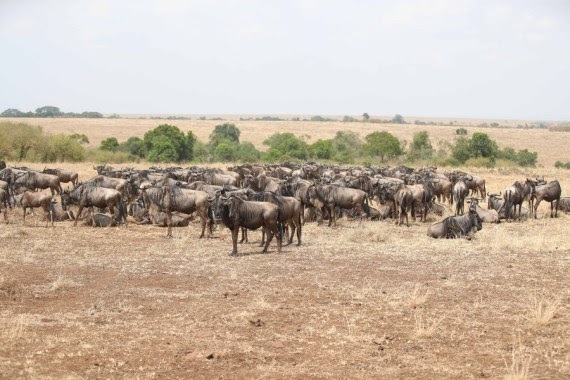Kenya’s iconic wildebeest migration suffers disruptions amid climate change
By Xinhua News Agency, September 15, 2021The sight of brown grassland that greets visitors to the well-known Maasai Mara game reserve in southwestern Kenya reaffirms a growing consensus that dry spells have taken a toll on the pristine haven for iconic wildlife species.
Often regarded as Kenya’s jewel thanks to its lush vegetation, idyllic setting and presence of iconic land mammals like elephants and rhinos, the Mara is slowly losing its luster amid climate change induced recurrent droughts.
Thanks to depressed rains this year, the normally tall green grass at the Mara has withered, exposing the ground to harsh elements while pushing a huge population of herbivores to the brink of starvation.
In addition, water levels in the Mara River have sunk to historic lows as delayed and suppressed rains became the norm this year in Kenya, with experts blaming global warming for the change.
“The great wildebeest migration from Tanzania’s Serengeti National Park to the Mara has suffered some disruptions due to harsh weather conditions. Dubbed the “eighth wonder of the world,” the wildebeests’ great trek that culminates in their spectacular jump to cross the Mara River, has lately encountered hiccups, worrying Kenyan officials and conservationists.
Najib Balala, the cabinet secretary in the Ministry of Tourism and Wildlife, admitted that climate change impacts like delayed rains have altered the calendar for the great wildebeest migration.
“We can see clearly there is more rain in Tanzania now than in Kenya. So, the wildebeests are now stuck in Tanzania because of climate change. This same scenario happened 20 years ago,” Balala said during a recent interview with Xinhua.
He clarified that migration of wildebeests from Serengeti to the Mara has often taken place from mid-July to October, adding that in the event there are ample rains in Kenya, they can begin arriving in mid-June.
Kenya has leveraged the great wildebeest migration to raise the country’s visibility as a prime destination for international tourists keen to sample its abundant wildlife heritage, said Balala, noting that migration of wildebeests in the middle of 2020 injected vitality into the tourism sector after months of downturn, as travellers trooped to Maasai Mara game reserve to watch the iconic herbivores.
Kenya’s wildlife scientists said this year’s edition of the great wildebeest migration has delayed significantly citing drier than usual weather conditions in the country.
Patrick Omondi, director of Wildlife Research and Training Institute, said that climate change induced droughts in both Kenya and Tanzania have affected migration timelines and the size of the herd. He said the seasonal movement of herbivores from Serengeti to the Mara is driven by search for fodder and water besides an ideal environment to breed.
“They normally migrate from Serengeti immediately after the long rains season in Kenya at around May when pasture is blooming in the Mara,” said Omondi.
“But with failed rains most of the year, we have witnessed very few wildebeests migrating to the Mara. Their migration cannot be guaranteed in the event of dry weather and lack of pasture on the Kenyan side.”
Nancy Githaiga, African Wildlife Foundation (AWF) Kenya Country director, said that an estimated 1.2 million wildebeests often migrate from Serengeti to the Mara, adding that the event is key to Kenya’s tourism recovery. Githaiga said that climate change and habitats depletion have altered the herbivores’ migration dynamics.
Her sentiments were shared by Shadrack Ngene, head of Wildlife Population and Habitat Dynamics at Wildlife Research and Training Institute, who said that this year’s wildebeest migration has been muted due to a prolonged dry spell around the Mara ecosystem.
According to Ngene, the possibility of massive herd of wildebeests’ migration from Serengeti to the Mara seems remote as sufficient rains that could allow pasture to flourish elude the ecosystem that straddles Kenya-Tanzania border.
He said that in the absence of robust climate change mitigation and adaptation measures, the future outlook for the Mara ecosystem looks dire, to the detriment of wildebeests migration and Kenya’s tourism sector.
Kenya’s expansive southwestern plains where the Mara is situated have suffered harsh climatic conditions since the beginning of the year, thereby taking a toll on pastoralism, subsistence farming and wildlife conservation. Bernard Chanzu, deputy director of Department of Metrological Services, said the Mara ecosystem experienced depressed rains from March to May and dry cold weather from June to August, leading to withering of vegetation.
“The drought situation that has been reported in southwestern sector including the Mara is expected to escalate, leading to lack of pasture that might worsen human-wildlife conflicts,” said Chanzu.
Kenyan President Uhuru Kenyatta last week declared drought, which has affected an estimated 1.2 million citizens in arid and semi-arid lands, a national disaster. WWF Kenya Mau Mara Loita Sub Landscape Coordinator Samson Lenjirr admitted that competition for pasture and water, amid climate induced droughts, has fuelled clashes between wildlife and nomads at the Mara ecosystem.
“Yes it is true we have had several incidents of human wildlife conflicts as a result of climate change, as wildlife trespass on human settlements and farms in search of pasture and water,” said Lenjirr. “In the last one month, we had two incidents of human-wildlife conflict. But those incidents have now declined compared to previous years.”
He added that strategic interventions like encouraging nomadic communities to appreciate the value of wildlife, securing migratory corridors and construction of predator proof homes, have been rolled out in the Mara ecosystem to reduce human-wildlife clashes.
